BSc 1st Year Botany Hepaticopsida Sample Model Practice Question Answer Papers
BSc 1st Year Botany Hepaticopsida Sample Model Practice Question Answer Papers: BSc is a three-year program in most universities. Some of the universities also offer BSc Honours. After getting enrolled for BSc, there are certain things you require the most to get better grades/marks in BSc. Out of those, there are BSc Study Material, BSc Sample Model Practice Mock Question Answer Papers along with BSc Previous Year Papers. At gurujistudy.com you can easily get all these study materials and notes for free. Here in this post, we are happy to provide you with BSc 1st Year Botany Hepaticopsida Sample Model Practice Question Answer Papers.

BSc 1st Year Botany Hepaticopsida Sample Model Practice Question Answer Papers
Q.1. Write an illustrated account of the life history of Riccia.
Ans.1. The life history of Riccia consists of two distinct phase called as haploid (gametophytic) and diploid (sprophytic). These two phases alternate with each other. The adult plant of Riccia is gemetophytic. Here, will discuss both the phases separately.
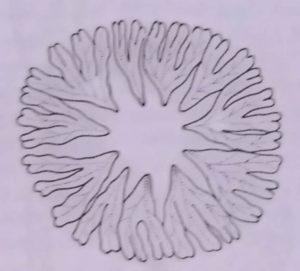
Distribution and Habitat: Riccia is a widely distributed liverwort which more than 200 species. The genus Riccia is a moist and shade loving plant, terrestrial in habitat, commonly occurring on moist walls, soil, banks of rivers etc. normally in rainy seasons, Riccia fluitans is the aquatic species, rest are terrestrial, Riccia reticulata is a xerophytic species. Several species of Riccia has been reported by Kashyap and others from various regions of India such as Manali, Kulu, Simla and various parts of Western Himalayas. The common India species are R himalayensis, R. robusta, R. kashypaii, R. tuberculata, etc.
Ramudar in 1970 reported 12 species of Riccia from Eastern Himalaya, 13 species from Western Himalaya, 16 species from Central India zone and 11 species from south India.
Gametophyte
Morphology: The mature gametophyte of Riccia is typically rosette like because of several dichotomous branches close to one another. Each branch of a thallus is linear to wedgeshaped, is thickned in the sagittal axis and has a conspicuous median longitudinal furrow on the dorsal side. The ventral surface of the growing apex of a branch bears a transverse row of scales one cell in thickness, which project forward overlap the growing point.
The ventral surface of the thallus towards the lower side bears the unicellular rhizoid; which serve the function of roots i.e., absorption and fixation. The rhizoids in the case are of two types Smooth walled and Tuberculated. The tuberculated rhizoids have peg like in growths of the walls which project inwards into the lumen of the rhizoids.
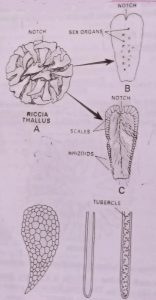
The scales are arranged in a transverse row. These are conspicuous multicellular, membranous, pink, red, violet or black and one celled thick structures. Scales contain anthocyanin pigment which in a very moist habitat may develop a faint green colour due to chlorophyll. They from continuous transverse strips toward the apex and project forward to protect growing points.
In the older portion, on account of the widening of the thallus, the basal part of each scale of torn apart from the mid-region into two separate portions, one near each lateral edge of the thallus appearing as if arranged in two rows. The prominence and persistence of these scales depend upon the nature of habitat of plant. In moist places, they are small and soon perish but in dry habitats they are large and persistent.
Different species of Riccia show variation in presence and absence of scales and rhizoids. In R. crysallina, the scales are absent or indistinct, in R. frostii both scales and tuberculate rhizoids are absent but in case of quatic species such as R. fluitans and R. natans both scales rhizoids are absent.
Anatomy: A vertical cross-section of thallus is differentiated into two clear regions a lower ventral region is composed of compact, colourless, parenchymatous tissue without intercellular spaces-the storage region and a upper dorsal region is composed of vertical rows chlorophyllus cells separated by air chambers and is known as assimilatory region or photosynthetic region. The entire thallus remains surrounded by a lower and upper epidermis. The lower epidermis on ventral surface is continuous and has rhizoids and scales, while the upper epidermis on dorsal surface is discontinuous and single layered. The function of the air pores is exchange of gases.
Assimilatory region of the thallus consists of unbranched green photosynthetic filaments. These filament are arranged in vertical rows each consisting of a single row of cells. Upper epidermis is discontinuous having larger usually non green cells. All other cells of the filaments are alike and contain namerous discoid chloroplasts capable of manufacturing food.
Vertical rows of assimilatory filaments enclose vertical space which may be called air chambers, air canals or air channels. The air chambers may be narrow or wide due to compactly or lossely organised assimilatory filaments.
Storage zone: The assimilatory region merges gradually into a compact colourless, undifferentiated parenchymatous storage region. The cells of this region are comparatively larger thin-walled and devoid of chloroplast and intercellular species.
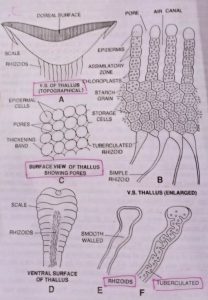
Prominent reserve food granules occupy the major part of these cells. The lowermost layer of the thallus bounding storage region is the lower epidermis. It consists of apparently small cells, some of which give off unicellular rhizoids and multicellular outgrowths scales for the purpose of anchorage, retention and absorption of water, protection of growing point and assimilation of food. Rhizoids are produced in the mid-ventral region whereas the scales at the margins.
Reproduction: Usually takes place by the following two methods:
- Vegetative
- Sexual

Vegetative reproduction: It may take place by the following methods:
(i) By progressive growth of the apical region and death of the older region or death and decay method: In most of the species after attaining maturity the older parts of thallus die and decay, the younger parts thus separate from the older ones and lead, an independent life.
(ii) By adventitious branches formation: In some species and adventitious branches arise from the ventral surface of the thallus, and the separation of these branches results in the formation of new thalli. In R. fluitans such adventitious branches are formed in larger numbers.
(ii) By tuber formation: In some species their arise tuber like outgrowth which are capable of producing new plants-as for e.g., in Riccia vesicosa
(iv) Apices of the plants get embedded: In some species as for e.g., R. himalayensis, the apex of the thallus at the end of season grows sown into the soil and become thick. Next season it grows up and give rise to a new plant.
(v) By rhizoids: In some species e.g., R. glauca a young thallus may be formed at the apex of rhizoid in a manner similar to that by which the young thallus arisen from the germ tube of a germinating spore.
Sexual reproduction: In Riccia the sexual reproduction is of oogamous type. On attaining maturity, the thallus of Riccia bears the sex organs on its dorsal surface. The sexual reproduction takes place by definite male and female reproductive organs-which are known as Antheridium and Archegonium respectively. The plants may be monoecious e.g., R. robusta, R. crystallia, R. glauca or dioaci e.g., R. discolar R. curtisii, R. himalaynesis etc.
Male Reproductive Organs
The male reproductive organs of Riccia are known as the Antheridium which develops from a single superficial cell on the dorsal surface of thallus and known as antheridial initial cell. In protude out and become papillate and then divided by a transverse division forming a lower basal cell and upper outer cell. The lower basal cell undergoes further development and forms the embedded portion of the stalk of antheridium-while outer cell forms the rest of parts i.e., jacket layer, antherozoids etc.(BSc Botany Hepaticopsida Sample Practice Question Answers)
The outer cell divides by repeated transverse divisions as a result of which a filament of four superimposed cells is formed. The two lower cells are primary stalk cells and two upper the primary antheridial cells. The primary stalk cell be further development from the remaining portion of the stalk which the primary antheridial cells divide by two successive vertically walls at right to each other and forms two tiers of four cell each.
The cell of both these tiers then divide by pericilinal divisions and thus forms eight outer jacket initials and a central group of eight primary androgenial cell. The sterile Jacket initial divide anticlinally and form a single layered jacket of antheridium. The primary androgonial cells divide repeatedly and form numerous small androgonial cells or androcyte cells.
Each and rocyte divides by a diagonal division and formation of two androcytes or antherozoid mother cells and get metamorphosed into an antherozoid. At the time of metamorphosis of small extranuclear granule, the blepharoplast appears. The blepharoplast first increases in size the androcyte losses, its triangular shape and becomes some that rounded and then the blepharoplast begins to elongate into shaped body around the cells.
After this the nucleus assumes in the form of a crescent and become homogeneous. It then moves to the side of the blepharoplast and becomes so firmly united with it that only the apex of the blepharoplast is recognizable. At the anterior end of the blepharoplast two long flagella are formed. Thus, a mature antherozoid is formed which consist of an elongated nucleus and last with two long flagella. The cilia help of antherozoid in their movement. The antherozoid gets liberated free from the antheridium only when the moisture is present.
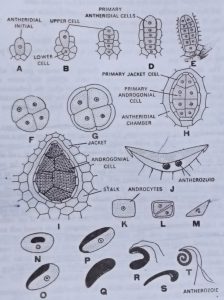
The mature antheridium is a club-shaped structure, consisting of a single jacket layer and several antherozoids.
The mature antheridium of Riccia consists of the following structures:
- A short few celled stalk which is attached to the base of antheridial body.
- The main body is an oval structure with flat base and conial apex. Sometimes the apex may be rounded.
- The main body has two distinct regions of thin walled cells.
(a) An outer sterile layer of thin walled cells called jacket layer.
(b) A central mass of large number of cubical androgonial cells. The androgonial cells divide to produce androcytes.
- The antheridium is enclosed within an antheridial chamber.
- The antheridial chamber communicates with air with the help of pore on the dorsal surface.(BSc Botany Hepaticopsida Sample Practice Question Answers)
The liberation of antherozoids: During favourable period when enough moisture is available, the jacket cells imbibe the water and disorganise to ooze out the mass of androcytes. Soon after, the antherozoids are formed and the liberated in semi-fluid surface film through which they swim and reach the archegonium. The rain drops help the entrance of antherozoids into the neck of the archegonium.
Female reproductive organs: The female reproductive organs of Riccia are known as Archegonium. The archegonium develops from a single superficial cell called as archegonial initial it, divides by a transverse division into a lower basal cell and upper outer cell. The basal cell after further divisions forms the embedded stalk of archegonium while the outer cell divides by three vertical divisions in such way that three peripheral cell surround a central primary axial cell. The three peripheral cell divides vertically and form 6 jacket cells, the contral axial cell divided tranversally and form an upper primary cover cell and the lower central cell.
The jacket cells divides transversally and forms two tiers of jacket each having six cells. The upper tier of cells called as neck initial and forms neck of six cells in height. Cell divides transversely into an upper primary neck canal cell and a lower primary venter cell. The primary neck canal cell further divide to form four neck canal cells and the primary venter cells forms a small venter canal cell and a large egg. Thus, the mature archegonium looks like a flask-shaped structure with a long neck and swollen venter with an egg.
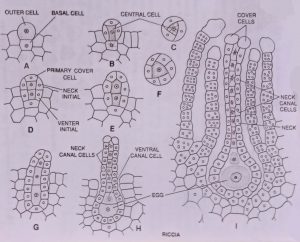
The structure of mature archegonium is as follows:
- A short few called invisible stalk which provides for attachment of the archegonium with the thallus.
- The archegonium appears as long necked flask shaped structure differentiated into venter and neck.
- The venter is a basal swollen part of the archegonium. It consists of a single layered wall of usually more than six cells in and encloses a lower large egg with an upper small venter canal cell.
- The neck appears as a single layered, slender and elongated tube which encloses a narrow canal constituting of 4-6 neck canal cells in single row. The neck consists of 6-9 tiers of elongated cells arranged in six vertical rows forming the jacket.
- The upper part of the neck canal is caped by four specialized comparatively large cover (lid) cells.
- The whole archegonium is enclosed with an archegonial which communicate with the air through pore on dorsal side of chamber.
The number of the archegonia in each archegonial chamber is usually one or rarely two. A single egg occurs in each archegonium.
Fertilization: During the process of fertilization fusion of male and female gametes takes place. Water medium is essential for the process of fertilization. Just before fertilization, in the archegonium, cover cells separate, the neck canal cells and venter canal cell disintegrate and form a mucilaginous mass; due to which an open canal is formed. The free swimming antherozoids get attracted by some chemical substance formed by the archegonium and thus reach at the mouth of the neck, enter the canal and go into the Venter. Only one antherozoid ultimately fuses with egg resulting the formation of zygote or oospore (2x) which is diploid in nature.
Sporophyte
The Oospore or Zygote is the first cell or unit of sporophyte.
Germination of Zygote and Development of Sporophyte (Embryo): The Zygote secretes a cell wall of its own and without any resting state, begins to grow almost immediately. The zygote enlarges in size and fills up the entire space in the venter. The wall of venter undergoes several pericilinal and anticilinal division to form a calyptra which is two layered.
The zygote undergoes segmentation, its first division is transverse, second and third vertical resulting in the formation of 8 celled, structure (octant). This 8 celled Zygote or embryo divides by several irregular division to form a 20 to 40 celled multicellular structure. Now, a pericilinal division occurs which forms and outer layer of amphithecium and inters endothecium. Amphethecium forms the sterile jacket of sporopyte and cells of endothecium forms the spore mother cells. The spore mother cells which are diploid of sporophytic (2x) in nature divides by the reduction division (meiosis) and following by simple division (mitosis) resulting in the formation of four soires which are arranged firstly in tetrahedral manner.
The sporophyte in case of Riccia represents the simplest structure among bryophytes-as it has only a capsule with jacket and spores. There is no foot seta and no sterilization of sporogenous tissue in the capsule.
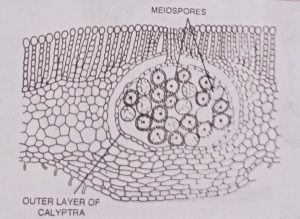
Thus, the mature sporophyte of Riccia which is housed in a sac provided by the parent gametophyte, is more or less rounded structure representing a spore sac, the capsule, there being no foot and seta. A mass of mature spores enclosed within the outer layer of calyptra is commonly designated as the sporogonium.
Cells of wall of calyptra and capsule are disorganised so as to form nourishing fluid for the developing spores. After the disintegration of capsule wall (the only diploid cells), the so called sporogonium in strict morphological sense, possesses no sporophytic cell and the mature spores remain enclosed in the outer layer of venter or in the cavity of thallus. The term sporogonium, therefore to this phase is incorrect. It is peculiar combination of time when the young gametophtic cells lie in the pocket of parent gametophtic cells.
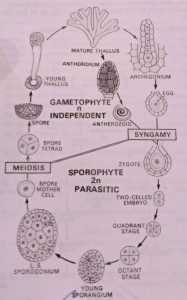
Spore dispersal: The spores of Riccia are dispersed without involving any special mechanism, i.e., by decay of capsule wall, calyptra and overlapping tissue of the thallus and carried by splashing rain drop or air. The newly formed spores are not liberated immediately but are set free after a year or so.
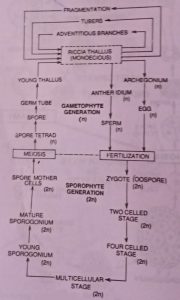
GAMETOPHYTE
The spore is the first cell or unit of gametophyte.
Structure and germination of spores and development of the young gametophyte.
Each spore is tetrahedral (pyramidal) is shape and have three layer viz exosporium outermost layer which is thin and cutinized, mesosporium, middle and the thick endosporium innermost and homogeneous.
The spores after dispersal and on getting a suitable substratum starts to germinate. The exosporium and mesosporium brusts and the endosporium form a germ tube which grows and forms fillentous structure known as protonema. The apical portion of the germ tube becomes multicellular while the lower portion produced the Rhizoids. The apical portion of germ tube divides irregularly, growth get check up in the centre resulting in the formation of young gametophytic thallus of Riccia.
BSc 1st Year Botany Hepaticopsida Sample Model Practice Question Answer Papers
BSc 1st Year Sample Model Practice Mock Test Question Answer Papers